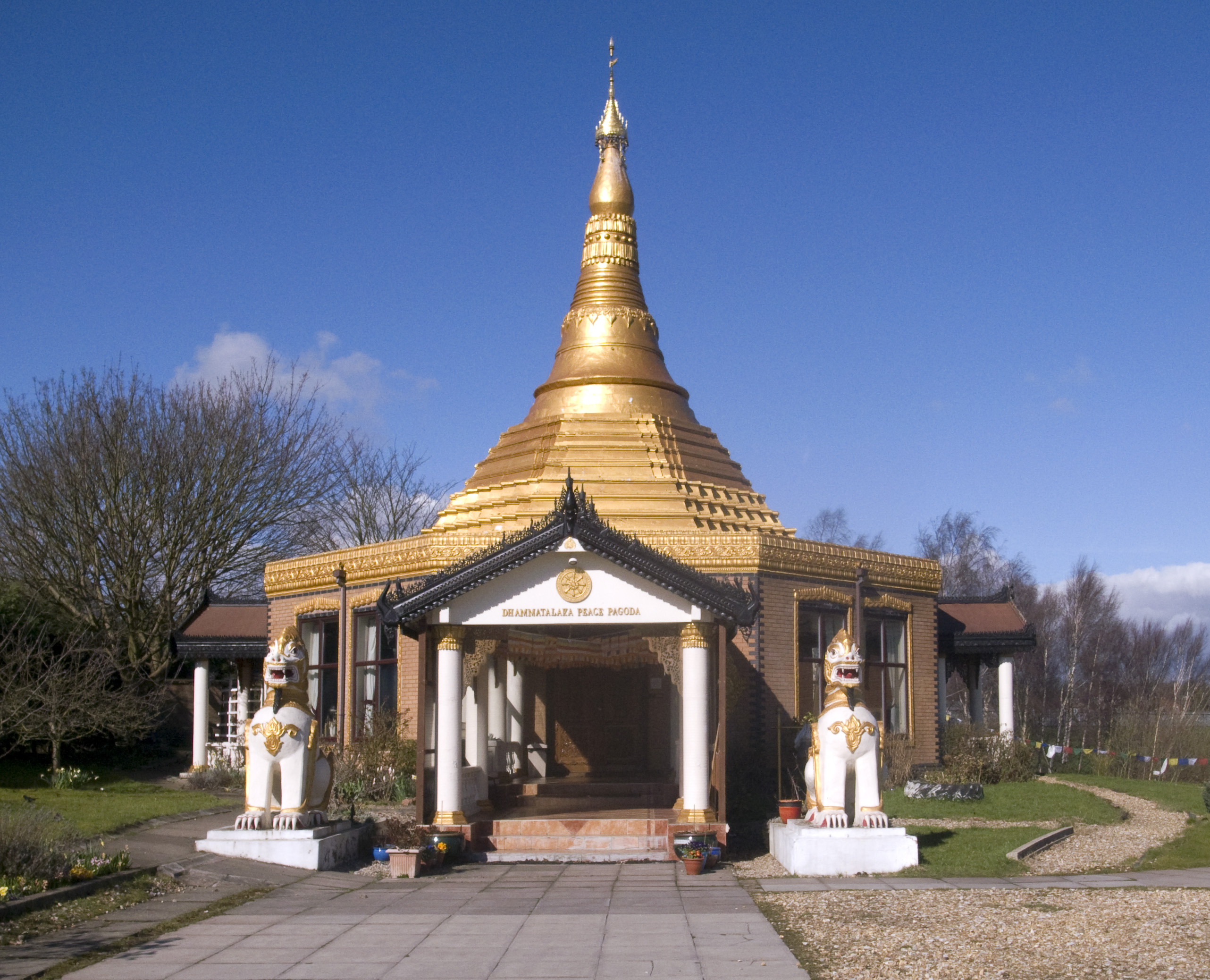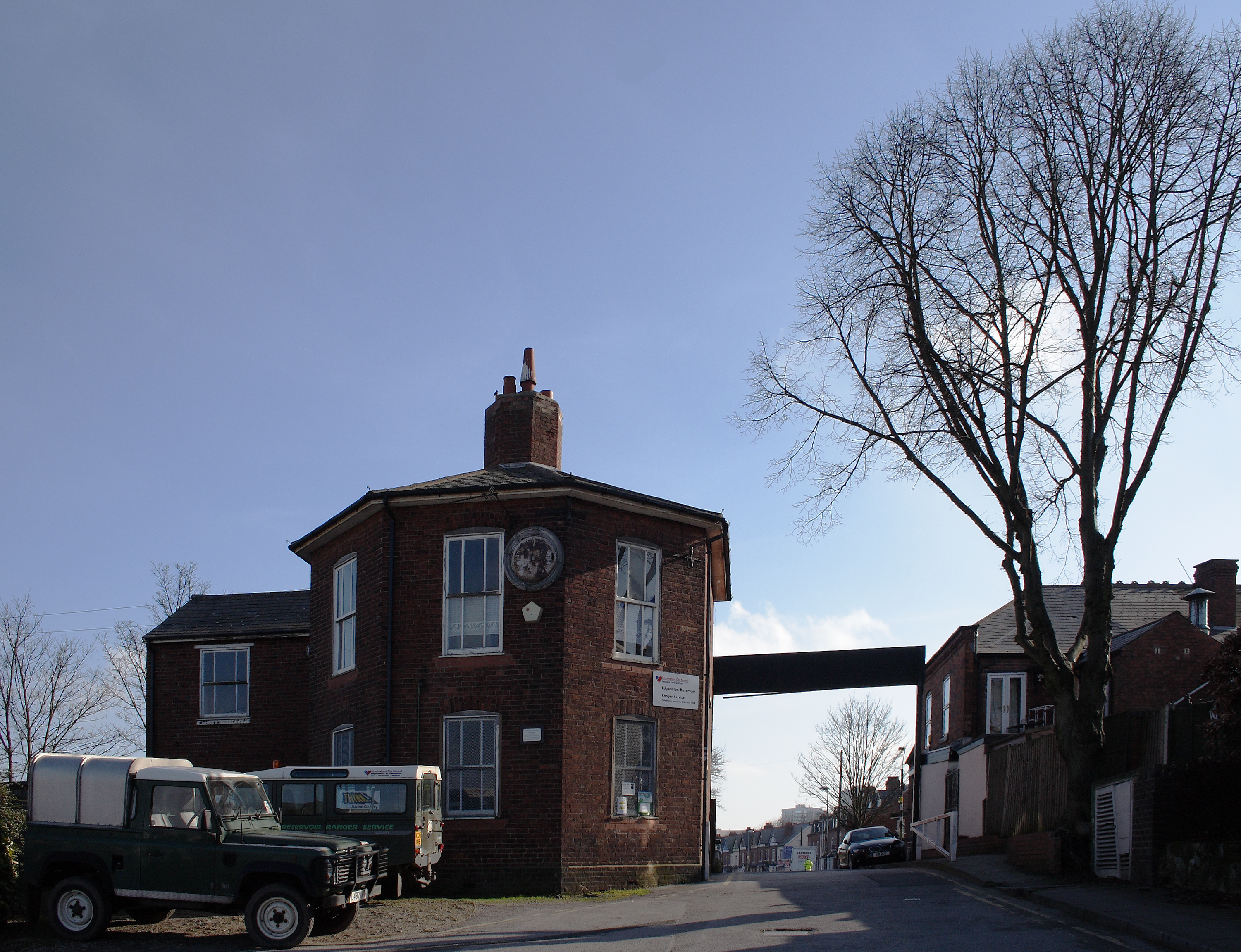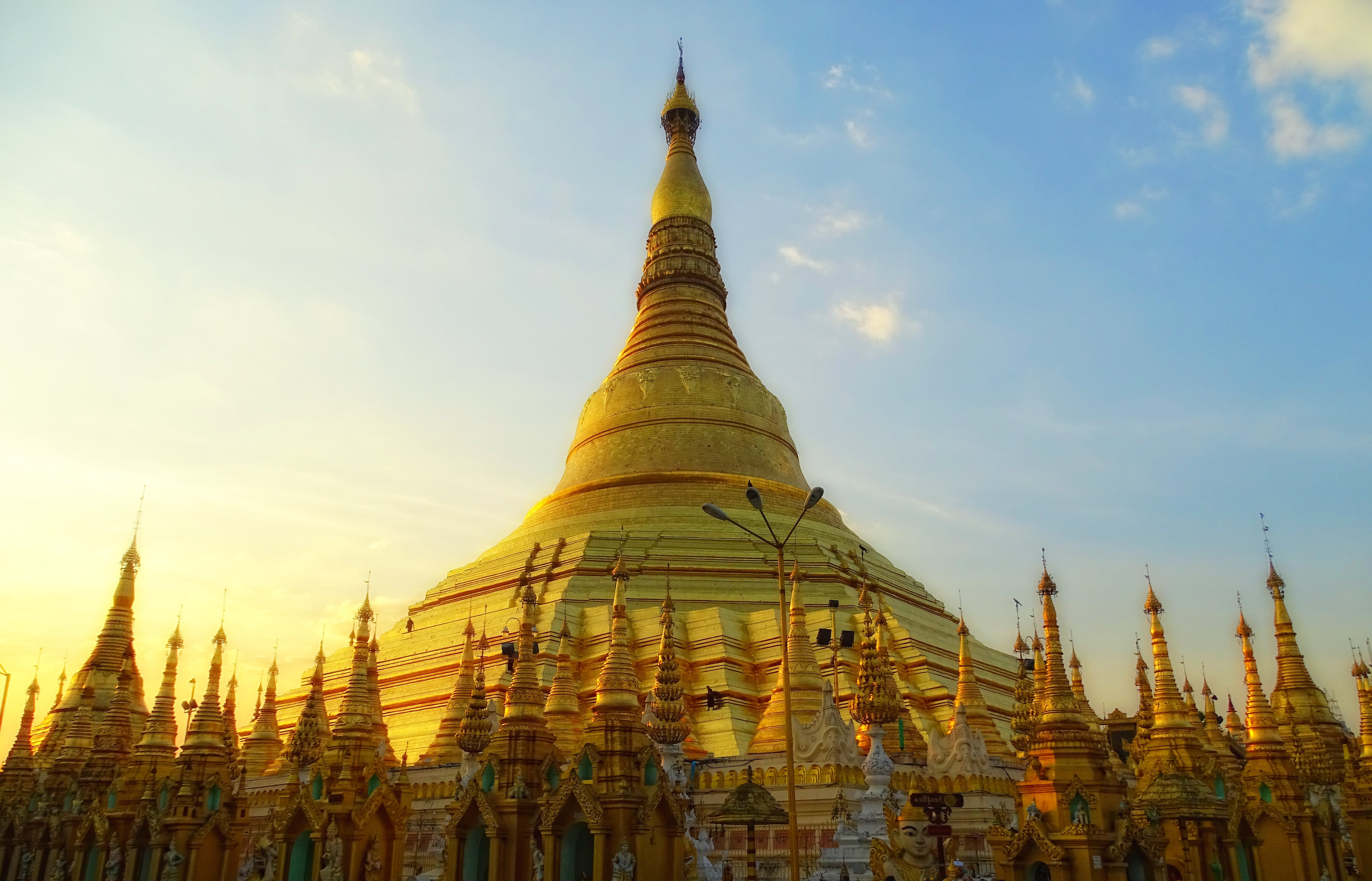|
Dhamma Talaka Peace Pagoda
Dhamma Talaka Peace Pagoda was opened in Birmingham, UK in 1998 and is the only such building in traditional Burmese style in the Western hemisphere. On its grounds there are now a monastery and the teaching hall of a planned Buddhist Academy. Creating a pilgrimage site Dhamma Talaka Pagoda was planned by the renowned scholar and meditation teacher, Aggamahapandita Rewata Dhamma to enshrine the Buddha relics of the former Burmese royal family. Shared with visiting monks by the exiled former king Thibaw Min of Burma, the relics had been passed into Dr Rewata Dhamma’s keeping in 1964. The pagoda’s name means ‘Reservoir of the Teaching’ and refers to its situation behind the Edgbaston Reservoir, a leet from which forms the boundary on one side of the property. The site was dedicated in 1990 and the pagoda was officially opened at an international ceremony in 1998. In 2002 the Sangharama Monastery was built in the same grounds and the Rewata Dhamma teaching hall in 2007. T ... [...More Info...] [...Related Items...] OR: [Wikipedia] [Google] [Baidu] |
Dhamma Talaka Peace Pagoda, Birmingham
Dharma (; sa, धर्म, dharma, ; pi, dhamma, italic=yes) is a key concept with multiple meanings in Indian religions, such as Hinduism, Buddhism, Jainism, Sikhism and others. Although there is no direct single-word translation for ''dharma'' in European languages, it is commonly translated as "righteousness", "merit" or "religious and moral duties" governing individual conduct.Britannica, The Editors of Encyclopaedia. (9 April 2019)Dharma. ''Encyclopedia Britannica''. Accessed 14 September 2021. In Hinduism, dharma is one of the four components of the '' Puruṣārtha'', the aims of life, and signifies behaviours that are considered to be in accord with ''Ṛta'', the order that makes life and universe possible. It includes duties, rights, laws, conduct, virtues and "right way of living".see: *"Dharma", ''The Columbia Encyclopedia'', 6th Ed. (2013), Columbia University Press, Gale, ; *Steven Rosen (2006), Essential Hinduism, Praeger, , Chapter 3. It had a transte ... [...More Info...] [...Related Items...] OR: [Wikipedia] [Google] [Baidu] |
Birmingham
Birmingham ( ) is a city and metropolitan borough in the metropolitan county of West Midlands in England. It is the second-largest city in the United Kingdom with a population of 1.145 million in the city proper, 2.92 million in the West Midlands metropolitan county, and approximately 4.3 million in the wider metropolitan area. It is the largest UK metropolitan area outside of London. Birmingham is known as the second city of the United Kingdom. Located in the West Midlands region of England, approximately from London, Birmingham is considered to be the social, cultural, financial and commercial centre of the Midlands. Distinctively, Birmingham only has small rivers flowing through it, mainly the River Tame and its tributaries River Rea and River Cole – one of the closest main rivers is the Severn, approximately west of the city centre. Historically a market town in Warwickshire in the medieval period, Birmingham grew during the 18th century during the M ... [...More Info...] [...Related Items...] OR: [Wikipedia] [Google] [Baidu] |
Rewata Dhamma
Sayadaw U Rewata Dhamma ( pi, Revatadhamma; 4 December 1929, Thamangone – 26 May 2004, Birmingham) was a prominent Theravada Buddhist monk and noted Abhidhamma scholar from Myanmar (Burma). After pursuing an academic career in India for most of two decades, he accepted an invitation to head a Buddhist centre in Birmingham UK, and over the next three decades gained an international reputation as a teacher of meditation and an advocate of peace and reconciliation. Life and career The young Rewata was first ordained as a novice at the age of 12, and received higher ordination at the age of 20. In 1953, he was awarded the title Sasanadhaja Siripavara Dhammacariya, after achieving distinctions in a state examination in Pali. Then, having received a state scholarship, he left for India in 1956 to continue his education at Varanasi University, using the expanded name of Rewata Dhamma for his passport. In 1960, he obtained a BA in Mahayana Buddhism; in 1964 an MA in Sanskrit and Ind ... [...More Info...] [...Related Items...] OR: [Wikipedia] [Google] [Baidu] |
Thibaw Min
Thibaw Min, also Thebaw or Theebaw ( my, သီပေါမင်း, ; 1 January 1859 – 19 December 1916) was the last king of the Konbaung dynasty of Burma (Myanmar) and also the last Burmese monarch in the country's history. His reign ended when the forces of the Burmese Empire were defeated by the forces of the British Empire in the Third Anglo-Burmese War, on 29 November 1885, prior to its official annexation on 1 January 1886. Early life Prince Thibaw was born ''Maung'' Yay Set (), the son of King Mindon and one of his consorts, Laungshe Mibaya. Thibaw's mother had been banished from the palace court by Mindon and spent her final years as a thilashin, a kind of female Burmese Buddhist renunciant. During the early years of his life, Thibaw studied Buddhist texts at a '' kyaung'' to win his father's favor. He passed the ''Pahtamabyan'' religious examinations and gained respect and recognition from his father and the chief queen. One of Mindon's chief consor ... [...More Info...] [...Related Items...] OR: [Wikipedia] [Google] [Baidu] |
Edgbaston Reservoir
Edgbaston Reservoir, originally known as Rotton Park Reservoir and referred to in some early maps as Rock Pool Reservoir, is a canal feeder reservoir in Birmingham, England, maintained by the Canal & River Trust.Environment Agency public register of Large Raised Reservoirs, as at 2 November 2020, via It is situated close to Birmingham City Centre and is a Site of Importance for Nature Conservation. History Originally a small pool named Roach Pool in Rotton Park, it was extensively enlarged by Thomas Telford between 1824–1829 to supply water to the Birmingham and Wolverhampton Levels of the Birmingham Canal Navigations (BCN) canal system via Icknield Port Loop at the foot of the dam. It was excavated to a depth of 40 feet (12 metres) and covers an area of , holding of water, and was the largest expanse of water in Birmingham at the time. It is supplied by small streams and a feeder from Titford Reservoir (Titford Pools) in Oldbury. It was formed by damming a small stream. ... [...More Info...] [...Related Items...] OR: [Wikipedia] [Google] [Baidu] |
Mandalay
Mandalay ( or ; ) is the second-largest city in Myanmar, after Yangon. Located on the east bank of the Irrawaddy River, 631km (392 miles) (Road Distance) north of Yangon, the city has a population of 1,225,553 (2014 census). Mandalay was founded in 1857 by King Mindon, replacing Amarapura as the new royal capital of the Konbaung dynasty. It was Burma's final royal capital before the kingdom's annexation by the British Empire in 1885. Under British rule, Mandalay remained commercially and culturally important despite the rise of Yangon, the new capital of British Burma. The city suffered extensive destruction during the Japanese conquest of Burma in the Second World War. In 1948, Mandalay became part of the newly independent Union of Burma. Today, Mandalay is the economic centre of Upper Myanmar and considered the centre of Burmese culture. A continuing influx of illegal Chinese immigrants, mostly from Yunnan, since the late 20th century, has reshaped the city's ethnic ... [...More Info...] [...Related Items...] OR: [Wikipedia] [Google] [Baidu] |
Shwedagon Pagoda
The Shwedagon Pagoda (, ); mnw, ကျာ်ဒဂုၚ်; officially named ''Shwedagon Zedi Daw'' ( my, ရွှေတိဂုံစေတီတော်, , ) and also known as the Great Dagon Pagoda and the Golden Pagoda is a gilded stupa located in Yangon, Myanmar. The Shwedagon is the most sacred Buddhist pagoda in Myanmar, as it is believed to contain relics of the four previous Buddhas of the present kalpa. These relics include the staff of Kakusandha, the water filter of Koṇāgamana, a piece of the robe of Kassapa, and eight strands of hair from the head of Gautama. Built on the high Singuttara Hill, the tall pagoda stands above sea level,The pagoda's pinnacle height (to the tip of its ''hti'') is tall per (UNESCO 2018), and is built on the Singuttara Hill, which is tall per , and tall above sea level per and dominates the Yangon skyline. Yangon's zoning regulations, which cap the maximum height of buildings to above sea level (75% of the pagoda's sea l ... [...More Info...] [...Related Items...] OR: [Wikipedia] [Google] [Baidu] |
Yangon
Yangon ( my, ရန်ကုန်; ; ), formerly spelled as Rangoon, is the capital of the Yangon Region and the largest city of Myanmar (also known as Burma). Yangon served as the capital of Myanmar until 2006, when the military government relocated the administrative functions to the purpose-built capital city of Naypyidaw in north central Myanmar. With over 7 million people, Yangon is Myanmar's most populous city and its most important commercial centre. Yangon boasts the largest number of colonial-era buildings in Southeast Asia, and has a unique colonial-era urban core that is remarkably intact. The colonial-era commercial core is centered around the Sule Pagoda, which is reputed to be over 2,000 years old. The city is also home to the gilded Shwedagon Pagoda – Myanmar's most sacred and famous Buddhist pagoda. Yangon suffers from deeply inadequate infrastructure, especially compared to other major cities in Southeast Asia, such as Jakarta, Bangkok or Hanoi. Though ... [...More Info...] [...Related Items...] OR: [Wikipedia] [Google] [Baidu] |
Berlin Wall
The Berlin Wall (german: Berliner Mauer, ) was a guarded concrete barrier that encircled West Berlin from 1961 to 1989, separating it from East Berlin and East Germany (GDR). Construction of the Berlin Wall was commenced by the government of the GDR on 13 August 1961. It included guard towers placed along large concrete walls, accompanied by a wide area (later known as the "death strip") that contained anti-vehicle trenches, beds of nails and other defenses. The Eastern Bloc portrayed the Wall as protecting its population from fascist elements conspiring to prevent the "will of the people" from building a socialist state in the GDR. The authorities officially referred to the Berlin Wall as the ''Anti-Fascist Protection Rampart'' (german: Antifaschistischer Schutzwall, ). The West Berlin city government sometimes referred to it as the " Wall of Shame", a term coined by mayor Willy Brandt in reference to the Wall's restriction on freedom of movement. Along with the sepa ... [...More Info...] [...Related Items...] OR: [Wikipedia] [Google] [Baidu] |
Gyalwa Karmapa
The Karmapa (honorific title ''His Holiness the Gyalwa'' ��ྒྱལ་བ་, Victorious One''Karmapa'', more formally as ''Gyalwang'' ��ྒྱལ་དབང་ཀརྨ་པ་, King of Victorious Ones''Karmapa'', and informally as the ''Karmapa Lama'') is the head of the Karma Kagyu, the largest sub-school of the Kagyu (བཀའ་བརྒྱུད, ), itself one of the four major schools of Tibetan Buddhism. Karmapa was Tibet's first consciously incarnating lama. The historical seat of the Karmapas is Tsurphu Monastery in the Tolung valley of Tibet. The Karmapa's principal seat in exile is the Dharma Chakra Centre at Rumtek Monastery in Sikkim, India. His regional monastic seats are Karma Triyana Dharmachakra in New York and Dhagpo Kagyu Ling in Dordogne, France. Due to a controversy within the Karma Kagyu school over the recognition process, the identity of the current 17th Karmapa is disputed by some. See Karmapa controversy for details. Origin of the li ... [...More Info...] [...Related Items...] OR: [Wikipedia] [Google] [Baidu] |
Karma Kagyu
Karma Kagyu (), or Kamtsang Kagyu (), is a widely practiced and probably the second-largest lineage within the Kagyu school, one of the four major schools of Tibetan Buddhism. The lineage has long-standing monasteries in Tibet, China, Russia, Mongolia, India, Nepal and Bhutan, with current centres in over 60 countries. The spiritual head of the Karma Kagyu is the ''Gyalwa Karmapa''; the 2nd through 10th Karmapas were principal spiritual advisors to successive emperors of China. The Karma Kagyu are sometimes called the "Black Hat" lamas, in reference to the Black Crown worn by the Karmapa. The Kagyu lineage claims a continuity of oral instructions transmitted from master to disciple.La Lignée du Rosaire d’Or' (“The golden rosary lineage”). This emphasis is reflected in the literal meaning of ''Kagyu''. The first syllable, ''ka,'' is said to refer to the texts of Buddha's teachings and to the master's verbal instructions. ''Ka'' has the double meaning of the enlightened me ... [...More Info...] [...Related Items...] OR: [Wikipedia] [Google] [Baidu] |
Tibetan Buddhism
Tibetan Buddhism (also referred to as Indo-Tibetan Buddhism, Lamaism, Lamaistic Buddhism, Himalayan Buddhism, and Northern Buddhism) is the form of Buddhism practiced in Tibet and Bhutan, where it is the dominant religion. It is also in majority regions surrounding the Himalayan areas of India (such as Ladakh, Sikkim, Arunachal Pradesh, and a minority in Himachal Pradesh and Uttarakhand), in much of Central Asia, in the southern Siberian regions such as Tuva, and in Mongolia. Tibetan Buddhism evolved as a form of Mahāyāna Buddhism stemming from the latest stages of Indian Buddhism (which also included many Vajrayāna elements). It thus preserves many Indian Buddhist tantric practices of the post-Gupta early medieval period (500 to 1200 CE), along with numerous native Tibetan developments. In the pre-modern era, Tibetan Buddhism spread outside of Tibet primarily due to the influence of the Mongol Yuan dynasty (1271–1368), founded by Kublai Khan, which had rul ... [...More Info...] [...Related Items...] OR: [Wikipedia] [Google] [Baidu] |






.jpeg/1200px-Tibetan_Buddhism_(214837929).jpeg)